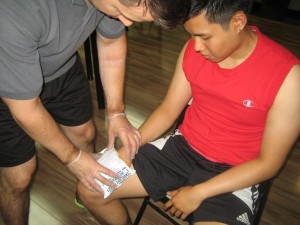Performing strenuous physical activity, especially something that is new to the body can lead to sore muscles. The muscles endure substantial physical stress when performing exercises. Mild soreness of the muscles is considered as a typical outcome when performing any physical activity usually in the beginning stages of a program.
[youtube url=”https://www.youtube.com/watch?v=QSulYGQXpv4″]The stress placed on the muscles while lifting weights or running will cause microscopic tearing of the muscle fibers and connective tissues. All the muscles of the body including in the abdomen can end up sore after performing intense training programs. Once an individual develops sore muscles, there is stiffness, swelling and tenderness of the affected muscle groups.
Treatment
- Apply a cold compress or ice pack on the sore muscles for the first 4 days. Cold therapy helps in constricting the blood vessels to prevent swelling, accumulation of fluids and to numb the nerve endings. Place some ice cubes in a plastic bag or bag of frozen vegetable and wrap it with a towel and then place it on the sore muscles for at least 20 minutes at 3 times every day as long as there is evident soreness.
Apply a cold compress or ice pack on the sore muscles for the first 4 days. - In a tub filled with cool water, mix ½ cup baking soda and then mix them well and soak the body in the solution at least 20 minutes at 1-3 times every day. Baking soda helps in neutralizing the lactic acid buildup in the muscles and repairs the pH balance of the body. Another option is to add Epsom salt to the bath. The magnesium and sulfate that is present in Epsom salt is absorbed in the skin and helps the muscles relax. Mix 2 cups of Epsom salt in the bath and soak the body for at least 12 minutes.
- Take plenty of rest at least 48-72 hours after performing a workout. It is not advisable to engage in any activity. Just perform mild range of motion exercises at least once every day such as arm circles, leg lifts, rotation of the legs and side bends to help increase blood circulation in the muscles. Perform 1-2 sets of 10-12 repetitions for each range of motion exercises. Stop activity if it triggers pain.
- Take the prescribed pain medications such as non-steroidal anti-inflammatory drugs (NSAIDs) such as aspirin or ibuprofen to help lessen the pain and discomfort caused by the sore muscles.
- Before relaxing in the recliner, stretch the muscles to help in preventing stiffening of the muscles and also makes them flexible and pliable.
- Drink plenty of water to avoid dehydration.
- Increase the consumption of poultry, fish, lean meats, lentils, nuts and quinoa.
Once the sore muscles are completely healed, he/she can gradually resume normal physical activities.

